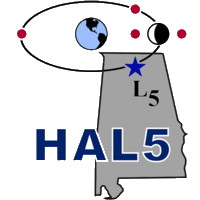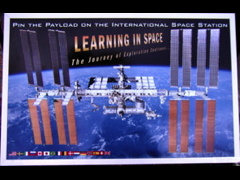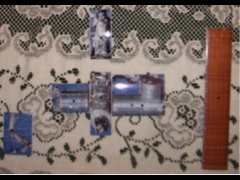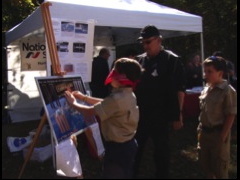Pin the Payload on International Space Station (ISS) Game
Copyright 2012 Huntsville Alabama L5 Society (HAL5)

Copyright 2012 Huntsville Alabama L5 Society (HAL5)
Pin the Payload on the International Space Station (ISS) game is
a HAL5 education outreach activity. The purpose of the game
is to educate the players on the main facts about the ISS, its major
international payloads (or modules) and their locations on the ISS.
The game was designed by HAL5 using images provided by NASA. The
game can be ordered directly from the manufacturer by other NSS
Chapters, schools, and non-profit organizations. The ISS image used
came from NASA poster [NASA Document Number: EB-2010-03-00020], and
placed on a custom made Muerase® magnetic dry erase board by
Digital Designed Solutions, Inc. of Charlotte, NC.
HAL5 obtained approval from NASA Headquarters for use and modification of
the original NASA image for the game. The list of changes can be
found at the bottom of the page. Six ISS payloads were identified
for game play and consist of European, Japanese, Russian and United
States modules/payloads, the Canadarm2, and a large Solar Panel.
Each payload was reproduced as a magnet for game play.
 Pin the Payload on the ISS Game Board
Pin the Payload on the ISS Game Board
 Pin the Payload on the ISS Game Pieces
Pin the Payload on the ISS Game Pieces
 Pin the Payload on the ISS Game Play at Astronomy Day 2012
Pin the Payload on the ISS Game Play at Astronomy Day 2012
The original cost of the game to HAL5 included the initial graphics fee that future ordering would not be assessed. Below is a general listing of the game prices if one were to order from Murease Graphics (803-329-9682) in 2012. The game board also comes with necessary hardware to attach to a dry wall. Additional hardware may be necessary depending on the setup. The game board, in 2012, carries a five-year warranty directly from Murease Graphics.
| Estimate of the Pin the Payload on the ISS Game Cost (Excluding Shipping and Tax) | ||
| Quantity | Description | Price |
| 1 | 19.25 inches (h) x 30 inches (w) Game Board | $90 |
| 1 | Set of 6 ISS Payloads Game Pieces Magnets | $24 |
| Sub Total | $114 | |
| Game Specifications | ||
| Board | ||
| International Space Station Board: | ||
| Outer: | 30.25 in x 19.5 in | |
| Inner: | 28.75 in x 18.2 in | |
| Magnets (Payloads): 1 set | ||
| American (Module): | 1 in x 3 in | |
| American (Solar Panel): | 1.25 in x 6.275 in | |
| Canadian: | 1.375 in x 2 in | |
| European: | 1.75 in x 1.375 in | |
| Japanese: | 2.5 in x 2 in | |
| Russian: | 1 in x 2.75 in | |
| Board Care | ||
| Wipe with dry erase eraser. Clean with soft cloth and dry erase cleaner or a solution of 25% isopropyl alcohol and 75% water (1:3 ratio). Do not use EXPO brand low order marker. Do not use wipes that contain ammonia chlorides or disinfectant. | ||
The Pin the Payload on the International Space Station game was
debuted at the 2012 VBAS Astronomy Day on October 20, 2012 as part of
the HAL5 outreach exhibit. In addition to the visual of the game board
drawing the players to the game. An explanation of the ISS was given to
all audience members according to their understanding, which increased
their interest in the ISS and the game. This game was well received.
A parent typically assisted children younger than five. Children under
the age of five would say the name of the part and then place it on the
ISS without using a blindfold. For children older than 5 and
adults, a blindfold was used. The competitive part of the game was established for the children really
trying to aim well. They were delighted with their placement once the
mask was removed.
Instruction
Robert Bijvoet, M.S., HAL5 Vice President, Former ISS Payload Integration Manager, Boeing
All the individual piece parts of the International Space Station (ISS)
were delivered either by the Russian Space Agency (RSA) using Russian
rockets or by NASA using the now retired Space Shuttles. The cargo bay
of the Space Shuttle, also called the payload bay, carried most of the
ISS hardware on numerous voyages. Everything not part of the Space
Shuttle itself mounted in the Cargo Bay or in the Space Shuttle Middeck
was considered a payload.
These big items located in the payload bay included the living and
experiment modules provided by NASA, the European Space Agency (ESA),
and the Japanese Space Agency (JAXA). Other
payloads carried in the Space Shuttle included the Port and Starboard
Truss segments, Heat rejection Subsystem (HRS) Radiators, numerous solar
panels, External Storage Platforms (ESP), The Mobile Base System (MBS),
Dextre (also known as Special Purpose Dexterous Manipulator), Express
Logistics Carriers (ELC), Alpha Magnetic Spectrometer-02 (AMS), and the
Canadarm2. The Canadarm2, Mobile Remote Servicer Base System (MBS), and
Dextre were provided by the Canadian Space Agency (CSA).
The original Canadarm was a part of the Space Shuttle itself and was mounted on the
edge of the cargo bay. The Spacelab, SPACEHAB, and Multi Purpose
Logisictis Modules (MPLM) modules, the Hubble Space Telescope, the Wake
Shield Facility, Space Radar Laboratories, Getaway Specials (GAS cans),
numerous satellites, probes as well as pallets were also among the
payloads carried in the shuttle cargo bay. Many of these "payloads" also
had payloads inside or on them (i.e. experiments, replacement hardware,
food, clothes, and lots of other hardware which allow astronauts to
live, sleep, and work in space).
ISS Modules delivered by the Space Shuttle include:
Modifications to the original ISS image are summarized below:
For more information about, question or feedback on the Pin the Payload on the ISS Game, please feel free via email.